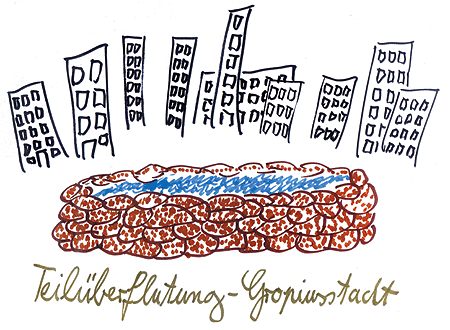
The original idea 'Partly Flooded Gropiusstadt' will not be realised, due to public sensitivity following the tsunami catastrophe in Asia. Instead, another idea titled: → 'Botanical nature trail of Karl-Marx-Strasse' is being carried out.
 Matthias Schamp (born in 1964) lives in Bochum |
Dear Birgit, Dear Uwe, Those troublesome double identities! Sometimes you confuse your head#s thought-through idea with your own arse. It appears to me that my own procedure was of just that sort. What I, in the introduction text, as a theoretician have asserted so nicely (project oriented works), and what so often distinguishes my work approach, is rather not fulfilled with my installation proposal. But what should I do? The part-flooding has taken to my heart. And one thing is even more important than any theory: Sometimes you have to move according to your own contradiction. Otherwise you end up with just carrying out programmes, which basically is terribly boring. In this respect, intentional interruptions and disappointing expectations also are a part of my work process. In this spirit, Matthias Partly flooded Gropiusstadt Project sketch: A certain part of the public space in Gropiusstadt will be enclosed by an embankment of sandbags and thereafter flooded. Necessary arrangements: Delivering the sand; providing the bags; filling the bags with sand; stacking the bags into an embankment; flooding the inner space created by the embankment. The ideal location would be a public square. The ground should be paved or asphalted in order to avoid the water leaking. Inside this area should be a hydrant from which the flooding is maintained. Any of the inhabitants’ uses or interpretations of the flooded area (e.g. paddling pool, well, bad omen or beer cooling device) should be left as open as possible. The flooding of the public space proves to be a real challenge, in particular regarding the concept of "private" versus "public", and even when it occurs in moderate form (a part-flooding). TV images of flood catastrophes have been imprinted on everyone. Suddenly the borders between the indoor (private) space and the outdoor (public) space seem torn down. A sort of double inversion takes place: The flood which invades the private household presents a suddenly hostile outside world, which breaks into a domain previously considered safe. On the other hand, interior objects are all of a sudden extracted from this domain and presented in such as way that their unforeseen and unplanned appearance inspires the public and possibly even creates media attention. Understood as intimate evidence of human existence, these objects seem, especially through their breakdown of function, to be usable as new kinds of indication. |

|